President's Message
Throughout history, stories or narratives, both oral and in literature, have been used in every culture as a means of sharing information. Many fictional stories in the form of fables or parables have been used to convey a moral lesson. These stories are passed from generation to generation, and interestingly enough, variations of the same story may be found from one country to another. One such parable is the story of "Stone Soup."
There once was a traveler who came to a small village, tired and weary from his long journey. The traveler did not have anything to eat and hoped that a friendly villager would be able to feed him. He came to the first house and knocked on the door. He asked the woman who answered if she could spare just a small bit of food as he had traveled a long journey and was very hungry. The woman replied, "I'm sorry I have nothing to give you. I can barely feed my own family."
So the traveler went to another door and asked again. The answer was the same: "I have nothing to give you." He went from door to door and each time was turned away.
Undaunted, the traveler went to the village square, took a small tin cooking pot from his bag, filled it with water, started a fire and dropped a stone in the pot. As he boiled the water, a passing villager stopped and asked him what he was doing. The traveler replied, "I'm making stone soup. Would you like to join me?" The villager said yes, and he asked if carrots were good in stone soup. "Sure," said the traveler.
The villager went home and returned with carrots from his garden to add to the boiling water. Soon, another curious villager came by and was invited to join them. She went home and returned with some potatoes. A young boy passed by and soon joined the group, bringing his mother and dinner plates from their home.
In time, a crowd gathered with everyone offering their own favorite ingredient: mushrooms, onions, salt, black pepper, acorn, squash. Everyone wanted to be part of the creation. Finally, the traveler removed the stone and declared, "The stone soup is ready!"
And the whole community joined in a feast where there was none before.
There are many versions and possible interpretations of this story but the message is the same: By working together, with everyone contributing what they can, a greater good is achieved.
As mentioned in the previous issue of the newsletter, we are sponsoring a series fundraising events in partnership with other organizations to build a kitchen for Meadow Farm Living History Museum. The first of these events will be a Colonial Tea Dance held at Walkerton Tavern in partnership with Friends of Meadow Farm and the Colonial Dance Club of Richmond. Information on this event can be found in this issue.
The Henrico County Historical Society is making stone soup. The partnerships we form with other organizations to achieve a common goal to benefit the community represent the ingredients of that soup. We hope you will join us in participating and make your contribution to the soup.And oh what a delicious soup it will be!
Sarah Pace
President
>Back to Top<
September Meeting: Join Us at Henricus Historical Park Saturday September 7 at 2:30
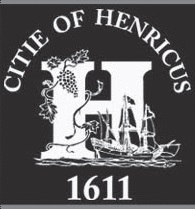
After the meeting we will be taking a walking tour of Henricus Historical Park, which re-creates the second successful English settlement in the New World.
In addition . . .
An optional pontoon boat tour will highlight nature and general history of Henricus and Dutch Gap. Excursions will last 45-minutes and begin at the floating dock at Henricus Historical Park. A maximum of six people may participate in each tour which costs $25 per person. Children under five years of age are not permitted on boat tours. Tours will take place at 1 p.m., 2 p.m. and 3 p.m.
Pre-registration for the boat tour is required by contacting Jessica Fields at (804)318-8728 or fieldsj@chesterfield.gov
How you get there . . .
From I-95 North or South: take Exit 61A
Follow Route 10 (Ironbridge Road) to first stoplight
Turn at left at first stoplight onto Route 732 (Old Stage Road) approximately 2 miles
Turn right at first stop sign onto Route 615 (Coxendale Road) approximately 1 mile
Turn right onto Henricus Park Road and follow for 1.3 miles
Arrive Henricus Historical Park!
>Back to Top<
Bylaw Change
Several changes to the HCHS bylaws have been suggested and are to be voted on at the September meeting. Directly below is the original wording of the bylaws with the changed areas in bold. Below this section is a section showing the proposed changes.
ORIGINAL BYLAW:
ARTICLE III − MEMBERS
Section 3. Annual dues shall become payable in advance on the first day of June in each year and shall be payable during that month. Notice that dues are due and payable shall be sent to all members by the Treasurer prior to May first. Dues not paid by July1 shall be considered in arrears, and if not paid within six months from notification, the Executive Board, after written notice requesting the payment of dues may, at its discretion, drop from membership any member whose dues are in arrears. Annual dues in arrears for twelve months shall automatically terminate membership. Reinstatement shall be treated as a new membership and admission shall be made in accordance with these bylaws.
PROPOSED CHANGES:
ARTICLE IV − OFFICERS & DUTIES
Section 1. The officers of the Society shall be a President, a First Vice-President, a Second Vice-President, a Recording Secretary, a Corresponding Secretary, a Treasurer, and five Directors, one from each magisterial district.
Section 2. At the February meeting of the Executive Board, a Nominating Committee of three members shall be appointed by the Board. It shall be the duty of this committee to nominate one candidate for each office to be filled at the annual meeting in June. The report of the Nominating Committee shall be included in the notice of the annual meeting mailed to all members. Additional nominations from the floor shall be permitted.
Section 5. In addition to the duties prescribed by the parliamentary authority adopted by the Society, the officers shall perform the following duties:
A. The President shall appoint the Chairman of each committee; the President shall be ex officio a member of all committees except for the Nominating Committee. The President shall report annually on the activities of the Society.
B. Each of the two Vice-Presidents shall perform such duties as may be assigned to them by the President.
C. The Recording Secretary shall acknowledge receipt of all acquisitions, whether by gift, loan, deposit, exchange or otherwise. Such acquisitions shall be reported annually by this officer.
D. The Corresponding Secretary shall send out all notices that may be required by these bylaws and shall perform such other duties as may be assigned by the President or the Board.
ARTICLE III − MEMBERS
Section 3. Annual dues shall become payable on the first day of January in each year and shall be payable during that month. Notice that dues are due and payable shall be sent to all members by the
Treasurer prior to January first. Dues not paid by February 1 shall be considered in arrears . . .
ARTICLE IV − OFFICERS & DUTIES
Section 1. The officers of the Society shall be a President, a Vice-President, a Secretary, a Treasurer, and five Directors, one from each magisterial district.Section 2. At the March meeting of the Executive Board, a Nominating Committee shall be appointed by the Board. It shall be the duty of this committee to nominate one candidate for each office to be filled at the annual meeting in June. The report of the Nominating Committee shall be included in the notice of the annual meeting mailed to all members. Additional nominations from the floor shall be permitted.
Section 5. In addition to the duties prescribed by the parliamentary authority adopted by the Society, the officers shall perform the following duties:
A. The President shall appoint the Chairman of each committee; the President shall be ex officio a member of all committees except for the Nominating Committee. The President shall report annually on the activities of the Society.
B. The Vice-President shall perform such duties as may be assigned to him or her by the President.
C. The Secretary shall send out all notices that may be required by these bylaws and shall perform such other duties as may be assigned by the President or the Board. The Secretary shall acknowledge receipt of all acquisitions, whether by gift, loan, deposit, exchange or otherwise. Such acquisitions shall be reported annually by this officer.
>Back to Top<
Varina Woman's Club Hosts HCHS at Clarke−Palmore House. June Meeting Features Outdoor Concert, Refreshments, and Tour
The Henrico Concert Band entertained the members of the Henrico County Historical Society with an outdoor performance at the June meeting at the Clarke−Palmore House. A medley of the anthems of the American armed services highlighted the concert.
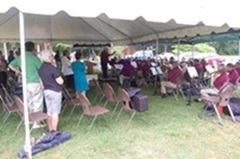
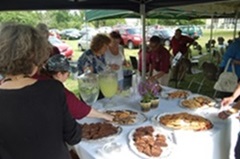
Afterwards, members and musicians enjoyed refreshments and a tour of the historic house. Built in stages beginning in 1819, this property was purchased by John Clarke in 1855. He added a second story, and his daughter Estelle and her husband John Palmore added the clapboard in 1910. In 1999, Vera Morton, daughter of John and Estelle Palmore, donated the house and 12 acres to Henrico County. The museum interprets the story of the Palmore family, who lived on this small farm during the Great Depression.
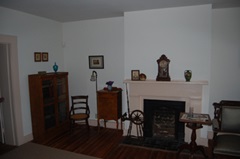
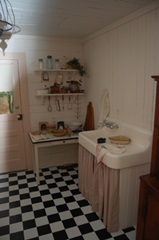
>Back to Top<
Reclaiming
John Shuck of our cemetery committee and volunteer Rich Dohm have photographed all of the gravestones in the three cemeteries behind the old Toys R Us on Quiocassin Road. The cemeteries are: Pryor Cemetery, Westwood Cemetery and Quiocassin Baptist Cemetery. Rich also photographed the gravestones which are in the Christian Family cemetery next to Cedar Fork Road in eastern Henrico. Work at East End Cemetery continues.
Reissuing
The Founders Club of Sandston has reissued the sold-out Sandston, Virginia: The First Twenty-Five Years, a compendium of family, group and town history since 1921.
Books cost $30, and are available from Alice Baldwin (804-737-1868) or Jame Evans (434-447-8668).
Re-enacting
Henrico County's Division of Recreation and Parks plans a 2014 re−enactment of the Battle of New Market Heights.
>Back to Top<
An Afternoon of Dance and Tea Presented by The Colonial Dance Club of Richmond & The Henrico County Historical Society.
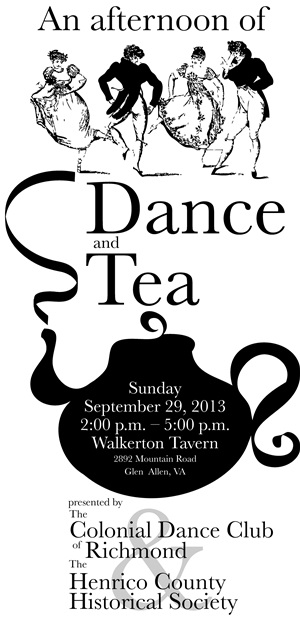
Please make plans to join us for a leisurely trip back in time at Henrico's historic Walkerton Tavern, where you will enjoy a presentation of colonial country dancing, sample exquisite specially blended teas served in fine bone chine and taste a variety of gourmet treats. Presented Sunday September 29th from 2:00p.m. to 5:00p.m. Dancing runs from 2:00-3:00 and 4:00-5:00. Tea is served 3:00-4:00. Period dress is optional. The cost is $20.
Make your reservation by calling Sarah Pace at 804-839-2407 or at shopping.html.
The Colonial Dance Club of Richmond is dedicated to the promotion and preservation of English Country Dancing.
Sponsored by Henrico County's Division of Recreation and Parks, we were established in 1977. Since then, our club has been busy introducing young and old to the dances that our country's founding fathers and early citizens so enjoyed.
In conjunction with the Henrico County Historical Society, the club is holding a "Dance and Tea," in the spirit of Regency−era social tea dances, at historic Walkerton Tavern.
You can step back to a genteel time and join us in learning these wonderful dances. We also welcome anyone to join our club and take part in this blend of history, fellowship, and fun that lasts a lifetime.
Claire Macdonald
President
Colonial Dance Club of Richmond
>Back to Top<
The HCHS and Friends of Meadow Farm Want You to Start Cooking
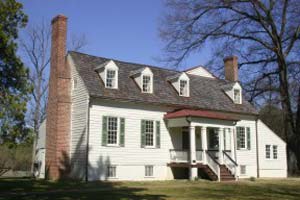
Picture this: you are visiting Crump Park and Meadow Farm Museum. As you start up the hill, you look up to see the farm house. There, off to the right side, there is something you have never seen before. What could it be? "There should be no new buildings on the grounds of the farm," you tell yourself.
Then you remember: "They've rebuilt the kitchen that was once on the property!"
Won't that be a wonderful reality? The kitchen was a center of activity and this one will be used to educate visitors to the foods of Dr. Shepherds' time as well as cooking methods. Won't it be tasty to try some of the foods grown and prepared at the Farm?
Let's all work together, along with other organizations, to make it happen. The 12th Virginia Regiment reenactors group is one of our supporters, along with the African American Committee and the Black History Museum in downtown Richmond. Your own president, Sarah Pace, and the Colonial Dance Club of Richmond are supporters. You can be a part of making the kitchen a reality.
Our groups are and will continue to raise funds for it and we encourage individuals to donate any amount to help build it.
Tinky Keen
President, The Friends of Meadow Farm
>Back to Top<
Meeting Culminates 3−Year Project
By Vicki Stephens
What began with what I thought would be a relatively simple research question has grown into a three-year project involving dozens of emails, hundreds of pages of information and hundreds of miles driven to search the details of the lives of three residents of Henrico: Benjamin Bunbury Allen, the founder of Glen Allen, his wife Susan Ann Sheppard of Meadow Farm and her second husband, Captain John Cussons, builder of Forest Lodge and part owner of the Cussons and May Co.
It all started in April 2010, when the HCHS received an email from Len Jolley of Essex, England, who was researching the family of Captain John Cussons, his great-great-great uncle. He had a number of questions, many of which we were able to answer.
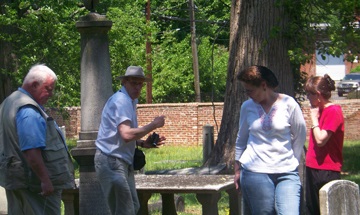
Fast forward to 2013: Len's wife, Michelle, gave him a trip to Richmond for his sixty−fifth birthday, and on May 12 we began our search to find the places he had read about. Our first stop was Hollywood Cemetery to find the graves of John and Susan. It had to have been quite emotional and gratifying to see the graves of people he had researched for over fifteen years.
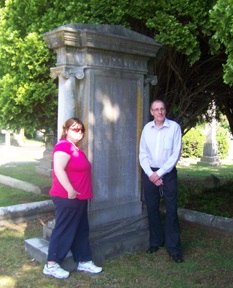
We also went of Meadow Farm, where Sandy Satterwhite provided us with a wealth of information on the Sheppards. Then at Shockoe Hill Cemetery John Taylor helped us dowse for Benjamin's grave. Len was able to verify that a male was buried beside John Allen. And the Virginia Historical Society provided pictures of the interior of Forest Lodge.
All in all, we found what Lend described as "more than I expected."
Special thanks to Sarah Pace, Sandy Satterwhite, Emmitt Allen, Kim Sicola, Pam Greene, John Taylor, Jeff Burden, librarians at the Virginia Historical Society and the staff at Meadow Farm.
>Back to Top<
James A. Patterson's Papers Provide Insight into Overseeing the County's Poor
Saved papers often live long after the savers have passed away. But why do people save seemingly random papers? Were they reminders of important people, places or events, or was it by mere accident that the papers survived?
The motivation to help the poor seems clearer−a manifestation of our innate altruism. Such is likely the case with James A. Patterson, who, according to a receipt among his few papers at the Virginia Historical Society−Mss2 P2773b) lived on twenty−five acres "lying in the Plank Road four miles from Richmond known as Alleys Tavern." Patterson served as an Overseer of the Poor from 1878 through at least 1899, becoming chairman in 1885.
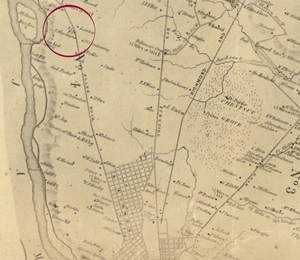
Circled on the 1864 Smith map of Henrico County is the location of Patterson's home "in the Plank Road four miles from Richmond".
The Overseers had a significant duty transporting indigents to the poorhouse and providing burial services for paupers. The minutes regularly cite payments for such services, and Patterson himself saved a 15 June 1880 hand-written receipt indicating on one side that "Thomas Spain Got a Order for a Coffin for Lewis Nicholas," Inside we find:
| April 21st | Buried Abert [sic] Trabue | 5.00 |
| May 2nd | for taking Charge of Child | 3.50 |
| June 12 | Bradford to the P House | 3.50 |
| June 16 | Buried Lewis Nicholas | 5.00 |
| " 21 | Buried Child Tom Williams | 3.50 |
However, his other few papers at the Virginia Historical Society allow us to glimpse the treatment of the poor at the time and perhaps reflect on his concern for particular cases.
One letter he had saved reads as follows:
Mr. James Patterson
Dear Sir:
To you, as Overseer of the Poor, I petition for Alms for Jenny Jones col. She is poor, old and growing blind. I think she has cataract [sic]. She is seventy years old, and very poor. Her children are dead, except one, that one she has not heard from for years. She came to me seeking a home.
Having been our slave, I could not turn her away. She served us in her strength, I would now support her in her weakness, but for pecuniary inability. I therefore beg you will aid me all you can, and you will greatly oblige.
Yours, very respectfully
Maria L. Woodward
Henrico, Nov. 15th, 1879.
Whether the alms were provided is unclear. While the Minutes for the Overseers of the Poor at the Library of Virginia often record payments to Patterson for "expenses paid poor of Tuckahoe Dist.," no such notation is recorded after the date above. The 1880 census does show Virginia Jones still living in the house of Maria L. Woodward, a widow of the Tuckahoe District of Henrico, as a servant/cook. This may have been on Quiocassin Road, since that was where the daughter Maria Woodward had been born. Mrs. Woodward's "pecuniary inability" apparently stemmed from the 1875 loss of her physician husband. Interestingly, Virginia, or Jenny, does not appear in the 1870 census as part of the household, so her absence from the Woodward household had been at least ten years long.
It is interesting that the requests for aid often apparently come from third parties rather than the impoverished parties. A 2 May 1899 request comes from a worker at the Powhatan Iron Works. An E.B. Pendleton writes:
To the Overseer of the Poor,
I feel it is my duty to let you know the condition & to ask assistance for Mrs. Baughn who has been left a widow in the last two days her husband [sic] health has been so that he has afforded her very little help for several months & she has strugled [sic] hard to support him herself & her children. She has four children two of them are provided for the other two are too young to leave her, she is destitute of anything at this time & no prospect to get anything unless the County will help her which I thin should be done imediately [sic] as she is a very worthy woman Industrious willing to do anything to make an honest living if she can get it to do but just at this time she has nothing to make a cent. I know all that I have writen [sic] to be true as I have lived a near neighbor for 7 or 8 years.
Again, the outcome of the request is not known, and one wonders why it was saved.
Sometimes the outcomes were known, but the disposition of funds allocated did not go smoothly. A folded, undated note addressed to Mr. Jim Patterson, Overseer of the Poor, Henrico Co. reads:
Mr. Patterson
Dear Sir
I did not fully understand what I was to do about the money ($12.00) for the little Negro girl at Mr. Courtneys. Am I to go to the courthouse or where shall I get it.
Resp
Mrs James
Grove Road-Near Soldiers House.
Such a note raises the question of how the funds eventually were to get to the recipient.
And some of the notes seem to indicate the personal interest taken in individual cases. Overseers, it seems, also helped to place the indigent in better conditions, and this may well have been the case with a man referred to as Alick. Patterson, a Scot, received a letter on 10 January 1888 from a fellow Scot, James Meare, of Yonkers, New York.
Dear Friend
I am almost ashamed of myself at being so long answering your letters . . .
[letter apologizes for not answering letters, gives some family “news” then goes on to say]
Now Mr Patterson you appear to be anxious to know about Alick. I will tell you he has been very fortunate in finding work, he was only one week in Yonkers when he got a job at 2$ a day and very well for 5 or 6 weeks when we did what we could to get him a better with more pay he succeeded at last and got 3 dollars per day a good steady place and we tryed to help him along so that he might soon be able to send for his family but we were disappointed he was geting to much money now it would appear for every time he went out he came in drunk I tryed to reason with him but it was no use he was very abusive when he had drink more especially to my wife when I was out so we had to tell him to get Board else where I felt to do it but I was compelled. We could not have drunk men coming about our house I hope it will make him think and see the folly of it and stop before it is to late [He mentions other mutual acquaintances follows and he closes]
Your Friend
James Meare.
Isn't it reasonable to assume that Alick was a charge of the Overseers of the Poor, and he had been helped to get to a place where could eventually provide for his family? While Meare's news is less than comforting, one can only hope that Alick eventually succeeded.
Again, the question arises: why did these few papers survive among what surely must have been many he received relevant to his service as Overseer? Were they significant cases? Had they touched him in some manner? Or were they just the ones that happened to survive? One would like to know.
>Back to Top<
Now You Know
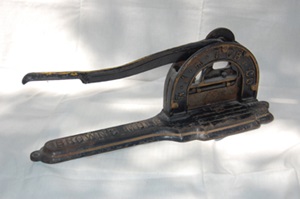
Tobacco cutters gave customers something to chew on.
The cast iron object pictured in the last issue's "What do you know?" was a tobacco plug cutter, made to cut compressed blocks of tobacco into smaller chunks. The cutter at the right is a Brown's Mule cutter, as the base plate says, and was made by R. J. Reynolds, indicated by the "R.J.R.TOB.CO" in raised letters around the blade.
The cutters were often given to shop owners who made significant purchases of particular tobacco, and the merchant then screwed the mechanism down to his counter (note the holes at each end) to stabilize it. Lengths of tobacco plugs were often divided by small creases to mark divisions for individual portions, or plugs could be cut into shorter lengths indicated by the halfinch division markings on the base beside the blade.
Tin tags, like the dime-sized Brown's Mule tag, identified the tobacco brand and were placed at intervals along the plug. The plug of Rainbow tobacco pictured at the right (about 3" x 4") has a single division and still features the original tags. The tags originally appeared in the 1870s and were made of wood. By the 1880s, tin tags had replaced them, and at one time over 12,000 different tags were in circulation.
>Back to Top<
What Do You Know?
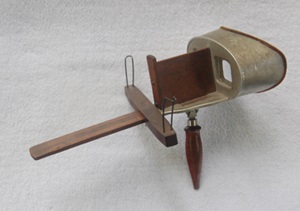
The item pictured above is 13 inches long. It is made of wood, glass and etched aluminum with metal clips on the crosspiece and a folding handle. The edge of the aluminum is lined with velvet.
Do you know what it is?
Email your answers to: jboehling@verizon.net
>Back to Top<
News 2013: Third Quarter
First Quarter | Second Quarter | Fourth Quarter
Home | Henrico | Maps | Genealogy | Preservation | Membership | Shopping | HCHS
|













